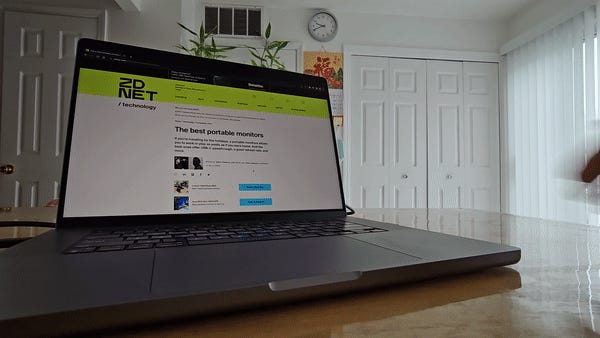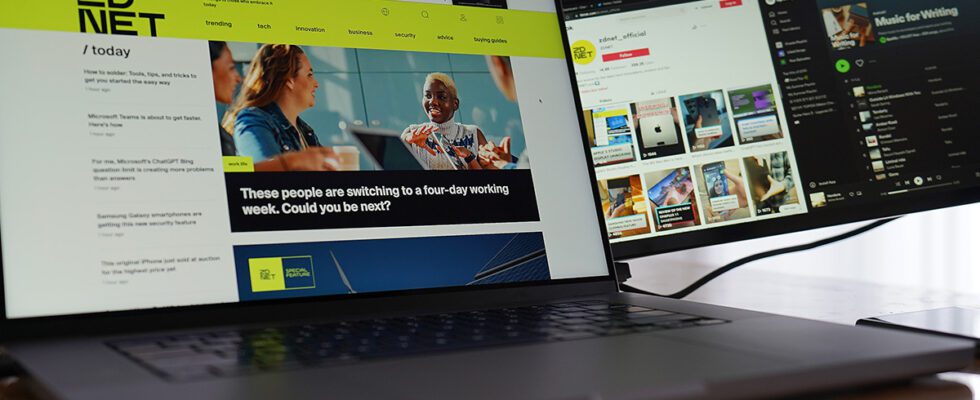Since pre-pandemic times, I’ve had an affinity for multi-screen setups. Strategically placing monitors based on available space (i.e. my desk) seemed like one of the headaches of my life, with the ultimate prize being increased productivity.
I would be lying if I said that I was as productive on a simple laptop as I was with two or three monitors that sent windows in my face.
In my search for a mobile productivity solution, I came across Mobile Pixels, which presented its product to me at CES earlier this year.
Unlike traditional portable monitors, the Duex Plus attaches to the back of your laptop using magnets and can be extended and tilted at will. The 321 euro monitor (I see one as I write these lines) is far from perfect; it doesn’t support touchscreens, isn’t the most color accurate, and is just barely suitable for outdoor use. But if you want the benefit of a dual-screen setup without having to carry around another monitor, this product is the best.
Monitor setup
At first glance, you might think that the initial installation of the Duex Plus is tedious, but it was far from the case, at least for me. The box includes the sliding screen, four magnets, an alcohol wipe, and a USB-C to USB-A/C cable. To install, start by removing dust and smudges from the surface of your laptop. Mobile Pixels says the Duex Plus should work with any laptop between 13 and 16 inches. I tested it with a 16-inch MacBook Pro.
After cleaning, position the four magnets in the places provided for this purpose on the base of the Duex Plus. Remove the adhesive backings and place the screen in the center of the laptop. Keep in mind that even after sticking the magnets to your laptop lid, you can still lift and tilt the monitor to the side you want it to slide to.
![]()
Image: June Wan/ZDNET.
The Duex Plus works with Windows laptops and MacBooks. And for display, it’s as easy as plugging in a USB-C plug. You don’t need to use an HDMI cable, which is great. Once I had everything set up, I simply had to pull the monitor out from the side and my MacBook automatically detected it, setting it to 1080p resolution and giving it its default color profile.

Image: June Wan/ZDNET.
Ease of use and performance
At this point, the Duex Plus is what you make it, whether you’re using it to have multiple windows, as a dedicated Nintendo Switch display, or to deliver a presentation in a meeting room. My typical working setup is to have my content management system open on the main laptop screen and a split-screen layout of Slack and any other relevant web pages on the Duex Plus. This way, I can focus on what’s in front of me while having quick access to background trading.
I also found the Duex Plus very useful for video editing. I’m not a creative professional and in no way recommend a portable monitor for your 4K/8K cinematic productions, but having more space to stretch the timeline and move workspaces freely was enough to improve my editing workflow. The same goes for photo editing. And for its price, you can manually adjust the display settings (contrast, saturation, brightness, etc.) of the Duex Plus using the physical buttons on the back of the monitor.
![]()
Image: June Wan/ZDNET.
The biggest question I had before I started testing was whether the extra screen would eat up a lot of battery. With the Duex Plus constantly on and its brightness set to maximum, I saw a 6-7% battery drop every hour, which is comparable to numbers I’ve had with other portable monitors. Remember, this is a 16-inch MacBook Pro M1. Your numbers may therefore vary.
There are portable monitors in all shapes and sizes, but the sliding mechanism of the Mobile Pixels Duex Plus is perhaps the most convenient way to integrate a second screen into your laptop. It’s not the only portable monitor to flaunt such a form factor, and the $321 price tag isn’t that cheap, as you can find a stand monitor for less, but the Duex Plus benefits from a well-thought-out design that blends in with any PC or Mac laptop.
Source: ZDNet.com
